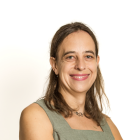Support strong Canadian climate journalism for 2025
For the last hour of every day of June, the massive screens that usually flash with advertisements above Yonge-Dundas Square are taken over by visual art students who used to work in sound studios and editing suites on the same block as the downtown meeting point.
Instead, in one video, passersby see distorted versions of real-life toddlers dressed up in products by social media “influencer” parents who get paid for the placements.
“It just made me think, like, baby pictures, you think of them as one of the most precious things that you have in your life. So, I was wondering what is the value of the human image in our social media age that we are living in?” said Nick Garel-Jones, the creator of Children of the Internet (Generative AI Demo) and curator of the video component of the collective exhibit.
The piece uses an algorithm the fourth-year student built that reads recurring patterns in all the samples it receives — the eyes, nose, mouth, and general facial features — and can extrapolate from that “to come up with new faces that it thinks are appropriate or look similar,” he explained.
In a scaled-up portrait on one of the square’s five screens that the group of film and photography students took over, a viewer would see Andrew Donnelly, with parts of his genome sequence written across the photographer’s body.
“It was this existential questioning of what it means to be able to see my entire physical being within a string of numbers on my computer,” said Donnelly, who mailed a vial of saliva off for sequencing last summer.
Donnelly, who curated the presentation’s still image portion, said a lot of the work his peers made this year felt more intimate than he's used to, more about themselves rather than the world.
“A lot of people chose to turn inward on themselves for their final project,” he said. “I think the state of the world always affects the art being made in it, and I definitely think you can see it in the work that was made this year.”

It was the first time the showcase event for experimental work by students of the image arts program at Ryerson University (known as X University among some faculty and students amid a formal review and informal debate about its name) has been displayed at the square.
The exhibit was an extension of the Rougher Film Festival, itself a part of the school's Maximum Exposure program to promote student work.
“Maybe this is a romantic idea, but I picture a person who has previously had no interest in the arts passing by the screen and seeing something that really affects them,” Donnelly said, while also acknowledging the yearning to see art in a gallery setting.
“The art within an art space feels much more alive to me rather than this public space that usually is for advertisements,” he said.
The oversized canvas also meant some works, including web-based game environments and a sound-reactive visualizer for music, couldn’t be displayed, but the collection otherwise came in multiple mediums, both analogue and digital film and photography, 3D animation, video game designs and music videos, Garel-Jones and Donnelly said.
The graduands said their final year of undergrad study, like many thousands across Toronto, was mostly confined to their homes, which meant no easy access to the school’s facilities and equipment, including a massive soundstage, more powerful computers and editing suites, camera gear and more experimental gear like VR headsets.
“It was difficult. I do feel in some ways my final year of studies was kind of taken from me,” said Donnelly. “But in a lot of ways, it allowed me, and maybe this is a bit narcissistic to say, but it helped me understand how much I can persevere in difficult circumstances.”
Access was particularly difficult for students who relied on using the equipment at school and lived farther from campus, he said.
Garel-Jones says while early technical issues were overcome, the distant learning had an impact.
“The biggest thing was the lack of routine and structure, and the Zoom fatigue overall really ate away at us, the professors as well,” he said. “We were all kind of depressed for a bit.”
He says quite a few classmates were expressive with their emotions during the year and were able to channel that into introspective work.
“But it clearly worked out because my classmates and I, we ended up with some really interesting final projects, and they're all really unique in their own ways.”
Morgan Sharp / Local Journalism Initiative / Canada’s National Observer





Comments